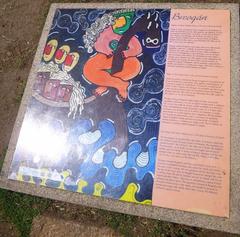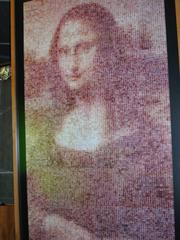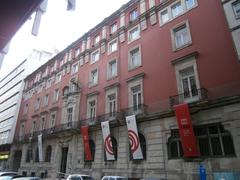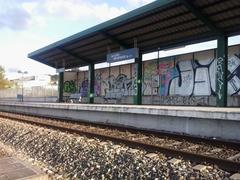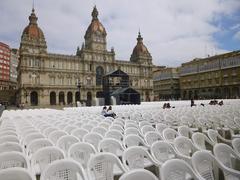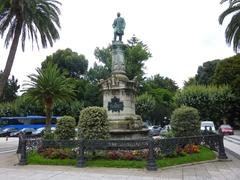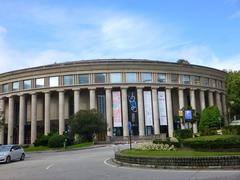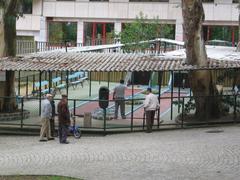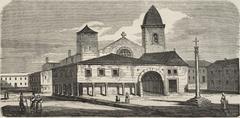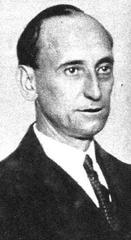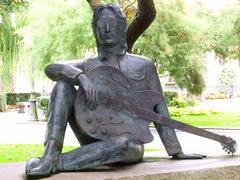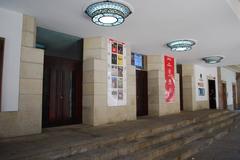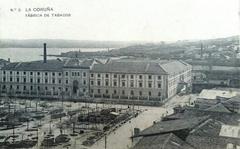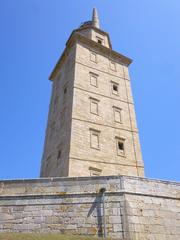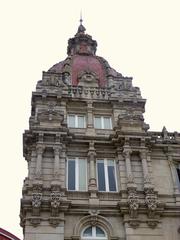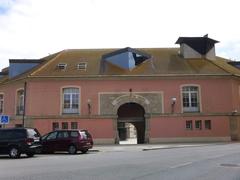
Museo Arqueolóxico e Histórico de A Coruña: Visitor Guide, Hours, Tickets, and Collections
Date: 03/07/2025
Introduction
The Museo Arqueolóxico e Histórico de A Coruña, set within the formidable Castillo de San Antón, offers a rich immersion into the archaeological and historical legacy of Galicia. This museum, housed in a restored 16th-century fortress originally constructed to protect A Coruña’s strategic port, harmoniously blends grand Renaissance military architecture with a vast collection of artifacts ranging from prehistory to the early modern era. Visitors engage with treasures such as the Casco de Leiro (Leiro Helmet), Celtic torques, Roman mosaics, and medieval sculptures, all within the evocative setting of a castle that has witnessed pivotal events—from the defense against Sir Francis Drake’s 1589 invasion to its later use as a prison and, ultimately, a provincial museum.
The museum’s unique position, boasting panoramic views of the Atlantic and the city, enhances its appeal. Its exhibitions narrate the evolution of Galicia’s societies—from megalithic and Celtic cultures to Roman and medieval developments—while also highlighting A Coruña’s maritime and urban history. Modern amenities, educational programming, and accessibility measures ensure a rewarding and inclusive experience for all visitors.
For current hours, ticket prices, and updates, refer to the Turismo de Galicia website and the A Coruña municipal portal.
Contents
- Origins and Architectural Significance
- Collections and Exhibitions
- Visiting Hours and Ticket Information
- Accessibility and Visitor Services
- Educational Programs and Events
- Practical Tips and Nearby Attractions
- Frequently Asked Questions (FAQ)
- Summary and Final Recommendations
- Sources
Origins and Architectural Significance
Historical Evolution of Castillo de San Antón
Constructed in 1588 on the former island of Illa da Pena Grande, the Castillo de San Antón was pivotal to A Coruña’s coastal defense system. It played a decisive role during the late 16th century, notably in repelling Sir Francis Drake’s attempted invasion. Over time, its function shifted from fortress to prison—housing military and political prisoners during the 18th to 20th centuries—and later to a protected historic monument in 1949. The site was inaugurated as a museum in 1968, following significant restoration that balanced preservation of its Renaissance features with adaptation for public exhibitions.
Key Architectural Features
- Bastions and Ramparts: Defensive walls and artillery positions, now offering panoramic views.
- Governor’s House and Chapel: The upper floor contains the Casa del Gobernador and a neoclassical chapel with notable religious artworks.
- Dungeons and Courtyards: Former prison spaces now display medieval stonework, funerary monuments, and heraldic shields.
- Historic Water Cistern (La Cisterna): An ancient rainwater reservoir carved into the rock.
- Outdoor Exhibits: Including a megalithic cist and the reconstructed Borna boat, illustrating ancient maritime practices.
Collections and Exhibitions
Prehistory and Protohistory
The museum’s archaeological holdings span from the Paleolithic through the Iron Age, focusing on Galicia’s earliest cultures:
- Megalithic Artifacts: Menhirs, dolmens, and funerary stelae.
- Castro Culture: Bronze jewelry, weapons, pottery, and engraved stone slabs from hillfort settlements like Elviña and Borneiro.
- Celtic Goldwork: Notably, the Xanceda torques and the Casco de Leiro.
- Petroglyphs: Stone engravings with spiral and geometric motifs.
Roman Galicia
Showcasing A Coruña’s importance as a Roman port and administrative hub (Turismo de Galicia):
- Epigraphic Stones: Latin inscriptions, milestones, and funerary slabs.
- Mosaics and Architectural Fragments: Reconstructed elements from villas and public buildings.
- Everyday Objects: Amphorae, glassware, coins, and ceramics reflecting daily life and trade.
Medieval and Early Modern Collections
- Visigothic and Suevic Items: Jewelry and liturgical objects.
- Romanesque and Gothic Sculpture: Capitals and reliefs from regional churches, including connections to Master Mateo’s workshop.
- Arms and Armor: Swords, crossbows, and chainmail illustrating local martial traditions.
Numismatics and Epigraphy
- Coins: From Celtic staters to medieval and modern currency.
- Funerary Inscriptions and Charters: Stone slabs and illuminated manuscripts offering insights into genealogy and local history.
Ethnography and Maritime Heritage
- Fishing and Shipbuilding Tools: Traditional nets, hooks, and boat models.
- Costumes and Domestic Utensils: Showcasing regional traditions from the 18th to 20th centuries.
- Spanish Armada Relics: Cannonballs and navigational instruments from local shipwrecks.
Highlighted Exhibits
- Bronze Cauldron of Elviña
- Roman Mosaic of the Medusa
- Sword of Vimianzo
- 18th-century Nautical Astrolabe
- Ceramic Mural: On the terrace, depicting local legends (saposyprincesas.elmundo.es “opens in new tab”).
Temporary Exhibitions and Interactive Spaces
The museum regularly hosts special exhibitions on topics such as “Galicia and the Atlantic World” and “Women in Prehistoric Galicia,” along with workshops and hands-on activities for all ages.
Visiting Hours and Ticket Information
Opening Hours
- Winter (September to June):
- Tuesday to Saturday: 10:00–19:30
- Sundays & Public Holidays: 10:00–14:30
- Summer (July & August):
- Tuesday to Saturday: 10:00–21:00
- Sundays & Holidays: 10:00–15:00
- Closed: Mondays, January 1, Carnival Tuesday, December 24, 25, and 31 (coruna.gal “opens in new tab”).
Admission Fees
- General Admission: €2.06
- Reduced Admission: €1.03 (students, unemployed, seniors)
- Free Entry: Saturday mornings, educational groups (with prior arrangement), accredited guides, members of the Association of Friends of the Archaeological Museum, and ICOM members (viajes.lavozdegalicia.es “opens in new tab”).
Tickets can be purchased onsite or online at ticketing.coruna.gal “opens in new tab”.
Accessibility and Visitor Services
- Wheelchair Access: Ramps and elevators are available in key areas; some historic sections may be less accessible due to architectural limitations (museos.xunta.gal “opens in new tab”).
- Restrooms: Including accessible facilities.
- Library and Gift Shop: Located in the former Casa de Botes.
- Guided Tours: By prior arrangement; available in Spanish, Galician, and English.
- Workshops and Events: Regular talks, courses, and interactive activities for all ages.
Educational Programs and Events
The museum prioritizes education and community engagement through:
- School Group Visits: Tailored tours and interactive activities for various educational levels.
- Family Workshops: Hands-on archaeology and digital heritage experiences.
- Summer Camps: Programs blending heritage education with new technologies.
- Special Events: Participation in Día Internacional dos Monumentos e Sitios Históricos and themed exhibitions.
Practical Tips and Nearby Attractions
- Plan for 1.5–2 hours to fully explore the museum and castle grounds.
- Wear comfortable footwear suitable for cobblestones and stairs.
- Photography is allowed without flash; check for restrictions in temporary exhibitions.
- Combine your visit with other local attractions, such as the Tower of Hercules, Old Town of A Coruña, Aquarium Finisterrae, and the Mirador de San Pedro (trek.zone “opens in new tab”).
Frequently Asked Questions (FAQ)
Q: What are the Museo Arqueolóxico e Histórico de A Coruña visiting hours?
A: Opening hours vary seasonally; see above for details. Closed on Mondays and major holidays.
Q: How much are tickets and how can I buy them?
A: General admission is €2.06, reduced €1.03. Tickets can be purchased onsite or online.
Q: Is the museum accessible for people with disabilities?
A: Ramps and elevators are available, but some areas are limited due to the historic structure.
Q: Are guided tours available?
A: Yes, by prior arrangement and for educational groups.
Q: Can I take photographs inside?
A: Yes, but without flash; check for restrictions in temporary exhibits.
Summary and Final Recommendations
The Museo Arqueolóxico e Histórico de A Coruña stands as a cornerstone of Galicia’s cultural heritage, offering a compelling blend of archaeological treasures, historical exhibitions, and evocative architecture. With accessible facilities, dynamic programming, and a prime city-center location, it is a must-visit for anyone interested in the history and culture of northwestern Spain. For up-to-date details, consult the official Turismo de Galicia site and the A Coruña municipal website.
Make the most of your visit by booking guided tours, participating in workshops, and exploring the castle’s panoramic views. Download the Audiala app for audio guides and interactive content, and follow the museum’s social media channels for news of upcoming events and exhibitions.
Sources and Further Reading
- Turismo de Galicia: Museo Arqueolóxico e Histórico da Coruña
- A Coruña Municipal Website – Museo Arqueológico Castillo de San Antón
- Museos.Xunta.Gal – Museo Arqueolóxico e Histórico da Coruña
- Trek.Zone – Museo Arqueolóxico e Histórico da Coruña
- Viajes La Voz de Galicia – Qué ver en el Museo Arqueológico e Histórico de A Coruña
- Sapos y Princesas – Museo Arqueológico e Histórico Castillo de San Antón





